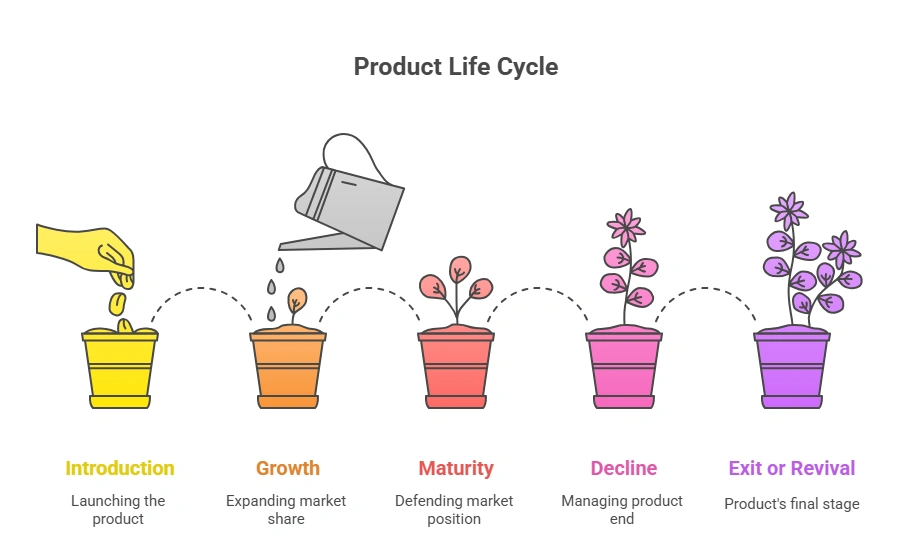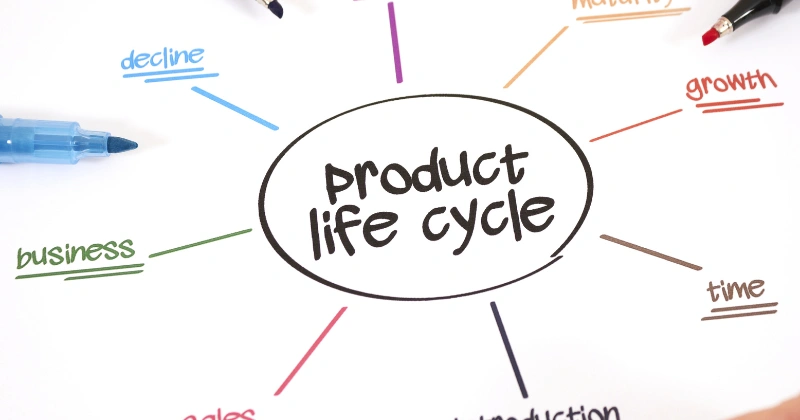Can you imagine introducing a product whose sales explode off the charts today — but becomes an ignominious failure two years later? Or, even worse, piling crores into dying product just plain because no one realized it was already there in the decline stage. That is precisely what occurs when businesses neglect Product Life Cycle Strategies.
It’s 2025 and the velocity at which products are conceived, produced and replaced is quite unlike anything we have ever seen before. A smartphone feature that’s hot today is outdated in six months. In fashion one minute, out the next. Winning brands aren’t always those with deepest pockets — they’re the ones who nail Product Life Cycle Strategies and pivot their Marketing Strategies at just the right time.
Understanding the Product Life Cycle in Today’s Market
The product life cycle (PLC) consists of four main stages: Introduction → Growth → Maturity → Decline. Historically, a product might have remained in maturity for years. Today, many digital and fashion products close the entire loop within 12–24 months.
But the realities of PLC strategy remain: each stage requires a radically different combination of decisions on product, price, promotion and distribution. Get it wrong and you get killed in the market. Miss and even a great product dies young.

In the hyper-competitive Indian market—where D2C brands, quick-commerce players, and global behemoths are all vying for the same customer—Product Life Cycle Strategies have emerged as the most potent competitive tool in any company’s arsenal.
Understanding Market Segmentation to Build Effective Marketing Plans
Stage 1: Introduction — Creating Demand and Early Adoption
This stage of the product life cycle is the most expensive and the riskiest of the stages. Initial sales volume is low and costs of development and pre-sale marketing activities are considerable, resulting in a negative profit whilst supporting product development and launch.
Some Important Elements of Pricing Strategy in Lifecycles in the Introduction Stage
- Skimming or penetration pricing (depending on your target market)
- Intensive above-the-line and digital promotional campaigns
- Selective promotional distribution to be aimed at early market achievers and the premium channels.
- Providing market education through demonstration videos, influencer marketing campaigns, and public relations practices.
As an example, boAt, during his influencer marketing penetration pricing strategy, was able to rapidly acquire attention of the early market achievers in the audio market and accumulated sales of 500 crore within three years of market entry.
The purpose of this stage is to attain product-market fit and create an initial market buzz.
Stage 2: Growth – Scaling While Competitors Are Still In Startup Mode
Rapid sales growth and increased profitability , while competition is entering the market (land grab phase).
Effective Strategies in Growth Stage of Lifecycles Include:
- Aggressive distribution expansion (i.e., from Flipkart to Amazon to quick-commerce to brick and mortar stores).
- Fund reallocation from brand awareness to sales (conversion through performance and retargeting).
- Line extension or improved product version introduction is encouraged.
- Defining customer loyalty is encouraged at this stage of your growth.
Mamaearth, for instance, during the growth stage, capitalized on the toxin-free marketing strategy and quick-commerce platforms while maintaining activity by adding new product variants promotional distribution to be aimed at early market achievers.
Goal: Attain the greatest market share before the opportunity is lost.
Stage 3: Maturity: Defending Your Throne
In the product life cycle, maturity is the longest – and the most profitable – stage. Profitability peaks, however, growth experiences a slowdown and intense competition begins. This is the stage where price wars start and fight for market dominance is at its highest.
Smart Product Life Cycle Strategies for the Maturity Stage:
- Differentiate the product from competitors via branding, packaging, or bundle offers.
- Harvest the profits, or invest in other product or brand extensions.
- Incentivize with heavy trade promotions and loyalty rewards.
- Waterfall your marketing efforts via shelf space and consumer mind space.
Example: Maggi has been in maturity for decades, and still dominates the market by frequent new flavour launches, heavy marketing with ATL campaigns during exam season, and school activation sponsorships to gain mindshare with students.
Goal: To maximize profits, and extend the profit sustainability of the product by delaying the product life cycle decline as long as possible.
Stage 4: Decline: Exit Gracefully or Reinvent
During the decline stage, sales drop and profit margins become negative. This stage is the most dangerous as most players exit the stage. Smart FIFO brands use this stage to generate immediate cash or discover a revival through smart marketing.
Advanced product life cycle strategies for decline stage:
- Cost Harvesting: Reduce marketing spend, and focus demand on sales channels where profit margins are highest.
- Revival: either repositioning the product, targeting a new market, or incorporating nostalgia marketing strategies to trigger consumer affinity.
- Divest to another brand: legally sell the brand in its entirety, or license use of the brand to another entity.
Example: Hajmola shifted from branding a product as “digestive candy,” to “fun tangy chatpata,” and marketed towards the new Gen-Z demographic, extending its life by decades.
Advanced Tactics: How Top Brands Extend the Life Cycle
Brand Extensions
Each season Lay’s releases new and “different” flavors of potato chips to extend the product’s life cycle. The new flavors are ‘different’ products since the season’s release is a new product launch.
Platform Strategies
Apple exploits the mature products within the ecosystem since the ecosystem is designed to grow and extend the product’s life cycle.
Nostalgia Marketing
Parle’s Londonderry and Campa Cola are products with 90’s nostalgia that have recently been updated.
Category Extensions
Amul provides new opportunities to “start anew” and refresh product life cycles. It all started with milk, then branched into butter, ice cream, cheese, and protein shakes.
Common Mistakes That Kill Products (And How to Avoid Them)
- Spending like it’s still growth when maturity has begun
- Ignoring line extensions and letting the product become “old”
- Cutting marketing spend too early in decline (losing loyalists)
- Launching price wars in maturity instead of differentiation
- Failing to track early warning signals (falling repeat rate, rising discounts)
Utilization of the Product Life Cycle Approach in Projects & Internships
Let’s say you are given a new project based on any brand (imaginary or real), let’s see how you should proceed following this framework:
Identify where the PLC is now from sales data and activity of competitors
- List current marketing mix
- Suggest specific changes required for subsequent steps
- Support it with monetary/profit impact (basic accounts)
For example: If a D2C skincare brand is experiencing 300% YoY growth → it’s in Growth stage → recommend moving 60% budget to performance marketing and quick-commerce channels.
The Future: Shorter Cycles, Smarter Strategies
In 2025 and beyond:
Fashion & electronics: 6–18 months cycles
D2C brands: New product every 3–4 months
AI tools now predict PLC stage shifts with 80%+ accuracy
The winners will be those who treat Product Life Cycle Strategies not as theory — but as a real-time war room dashboard.
Conclusion
Without a doubt, one of the primary reasons why brands maintain a certain level autonomy and dominance in the market is the Application of the Product Life Cycle Framework. Each of the brands requires the application of the Framework in execution, and this starts from knowing the stage the product is in, and matching it with the appropriate marketing strategies – be it building the next boAt, or defending the next Maggi or reviving the next Campa Cola.
This is the Framework which, once mastered, will change the way you view product launches, marketing campaigns, and even strategic pricing decisions in the future.
FAQ: Product Life Cycle Strategies
Can a product skip the introduction stage?
This is rare. Even the most disruptive products (such as UPI) had to deal with the introduction stage along it’s marketing campaigns.
How do I know which PLC stage my product is in?
This is determined based on the sales growth rate, the rate of repeat purchases, competition, and profit margins.
Is the decline stage always a bad thing?
Certainly not. Cash cows in a decline stage (such as basic detergents) actually make a lot of money while spending little on marketing.
Which stage is most profitable?
Late maturity: high sales + low spending on growth = peak profits.
Can a product go through multiple life cycles?
Certainly! Through repositioning, targeting new market segments, or nostalgia marketing as seen with Old Monk, Thums Up.
👨💼 Author: BBAProject Editorial Team
✍️ The BBAProject Editorial Team comprises business graduates and educators dedicated to creating practical, syllabus-based learning resources for BBA students.
⚠️ Please Note: Articles published on BBAProject.in are well-researched and regularly updated. However, students are advised to verify data, statistics, or references before using them for academic submissions.

